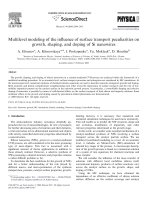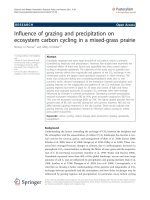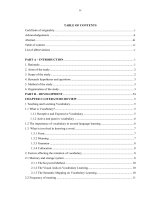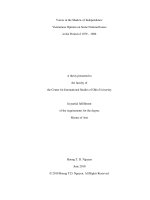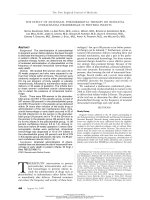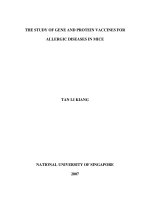The influence of dexmedetomidine and propofol on circulating cytokine levels in healthy subjects
Bạn đang xem bản rút gọn của tài liệu. Xem và tải ngay bản đầy đủ của tài liệu tại đây (648.79 KB, 8 trang )
Kallioinen et al. BMC Anesthesiology
(2019) 19:222
/>
RESEARCH ARTICLE
Open Access
The influence of dexmedetomidine and
propofol on circulating cytokine levels in
healthy subjects
Minna Kallioinen1* , Annalotta Scheinin1,2, Mikael Maksimow3, Jaakko Långsjö2,4, Kaike Kaisti2,5, Riikka Takala1,
Tero Vahlberg6, Katja Valli7,8, Marko Salmi3,9, Harry Scheinin1,2,10 and Anu Maksimow1
Abstract
Background: Surgery and diseases modify inflammatory responses and the immune system. Anesthetic agents also
have effects on the human immune system but the responses they induce may be altered or masked by the
surgical procedures or underlying illnesses. The aim of this study was to assess how single-drug dexmedetomidine
and propofol anesthesia without any surgical intervention alter acute immunological biomarkers in healthy subjects.
Methods: Thirty-five healthy, young male subjects were anesthetized using increasing concentrations of
dexmedetomidine (n = 18) or propofol (n = 17) until loss of responsiveness (LOR) was detected. The treatment
allocation was randomized. Multi-parametric immunoassays for the detection of 48 cytokines, chemokines and
growth factors were used. Concentrations were determined at baseline and at the highest drug concentration for
each subject.
Results: The changes in the concentration of eotaxin (decrease after dexmedetomidine) and platelet-derived
growth factor (PDGF, increase after propofol) were statistically significantly different between the groups. Significant
changes were detected within both groups; the concentrations of monocyte chemotactic protein 1, chemokine
ligand 27 and macrophage migration inhibitory factor were lower in both groups after the drug administration.
Dexmedetomidine decreased the concentration of eotaxin, interleukin-18, interleukin-2Rα, stem cell factor, stem cell
growth factor and vascular endothelial growth factor, and propofol decreased significantly the levels of hepatocyte
growth factor, IFN-γ-induced protein 10 and monokine induced by IFN-γ, and increased the levels of interleukin-17,
interleukin-5, interleukin-7 and PDGF.
Conclusions: Dexmedetomidine seemed to have an immunosuppressive effect on the immune system whereas
propofol seemed to induce mixed pro- and anti-inflammatory effects on the immune system. The choice of
anesthetic agent could be relevant when treating patients with compromised immunological defense mechanisms.
Trial registration: Before subject enrollment, the study was registered in the European Clinical Trials database
(EudraCT number 2013–001496-21, The Neural Mechanisms of Anesthesia and Human Consciousness) and in
ClinicalTrials.gov (Principal Investigator: Harry Scheinin, number NCT01889004, The Neural Mechanisms of Anesthesia
and Human Consciousness, Part 2, on the 23rd of June 2013).
Keywords: Dexmedetomidine, Propofol, Immunology, Immunosuppression, Cytokines
* Correspondence: ;
1
Department of Perioperative Services, Intensive Care and Pain Medicine,
Turku University Hospital, POB 52, 20521 Turku, Finland
Full list of author information is available at the end of the article
© The Author(s). 2019 Open Access This article is distributed under the terms of the Creative Commons Attribution 4.0
International License ( which permits unrestricted use, distribution, and
reproduction in any medium, provided you give appropriate credit to the original author(s) and the source, provide a link to
the Creative Commons license, and indicate if changes were made. The Creative Commons Public Domain Dedication waiver
( applies to the data made available in this article, unless otherwise stated.
Kallioinen et al. BMC Anesthesiology
(2019) 19:222
Background
Surgery is known to trigger an inflammatory reaction
[1], the magnitude of which depends on the type of surgery and the extent of tissue injury [2]. This postsurgical
inflammatory reaction is followed by depression in cell
mediated immunity, which in turn predisposes patients
to postoperative infections and sepsis [3]. In addition,
immunosuppression is also caused by volatile anesthetic
agents [4, 5]. The effects of anesthetic agents on
inflammatory cytokine profiles have previously been determined mostly in surgical patients or patients with
critical illnesses, when the immunological status has inevitably been altered due to the surgical intervention,
co-medication and/or the underlying disease [6–8]. Furthermore, since almost all of the studies on the effects of
anesthetic drugs on immunological responses have been
carried out in clinical settings, the patients have received
various combinations and concentrations of other drugs
such as opioids which also have effects on the humoral
and cellular immunological responses [9]. Considering
several confounding factors and wide methodological
variation between the previous studies, it is not surprising that contradictory results have been obtained [4, 10].
Dexmedetomidine, a highly selective adrenergic α2-receptor agonist, is being used for short-term sedation for
patients treated in the intensive care unit and also increasingly at the operating room during surgery. Propofol (2,6-diisopropylphenol) is a widely used intravenous
anesthetic agent that acts via GABAergic transmitter
system.
In vitro and in vivo experiments suggest that propofol
impairs innate immune response, and thus could possess
anti-inflammatory effects [6]. There is, however, contradictory evidence that propofol increases pro-inflammatory
response in endotoxemia [7, 11]. Dexmedetomidine seems
to have anti-inflammatory effects and be superior for sedating septic patients [12, 13]; yet, the effects of dexmedetomidine on cytokines, chemokines and growth factors have
not been systematically studied.
In order to reveal direct anesthetic related effects on
the immune system and compare immunological profiles
of two anesthetic drugs, we administered either dexmedetomidine or propofol to healthy male subjects in a
carefully standardized study setup.
Methods
The samples for this immunological project were collected during a larger study “The Neural Mechanisms of
Anesthesia and Human Consciousness (LOC-2013)” performed at the Turku University Hospital, Finland, after
approval by the Ethics Committee of the Hospital District of Southwest Finland (Turku, Finland) and the
Finnish Medicines Agency Fimea. Prior to enrolment of
subjects, this study was registered in the European
Page 2 of 8
Clinical Trials database (EudraCT number 2013 001496
21) and in ClinicalTrials.gov (NCT01889004, Part 2, 23
Jun 2013). This manuscript adheres to the applicable
CONSORT guidelines. More detailed description of the
study has been published elsewhere [14].
Study subjects
Thirty-five right-handed, healthy (American Society of
Anesthesiologists physical status class I), non-smoking,
20–30-year-old male subjects participated in the study.
The sample size differs from the original larger study (47
participants) due to technical and convenience issues in
laboratory analysis and only 35 samples could be analyzed at the time. All participants underwent an interview and laboratory tests, including a hearing test, drug
screen and an electrocardiogram. All subjects abstained
from alcohol use or medication for 48 h prior to study
sessions and fasted overnight. A written informed consent was acquired from all participants. Because the
same subjects later underwent also positron emission
tomography imaging and were exposed to radiation, only
male subjects were considered eligible. The sample size
was not based on a formal power calculation.
Study treatments
Dexmedetomidine (Dexdor 100 μg/ml, Orion Pharma,
Espoo, Finland) or propofol (Propofol-Lipuro 10 mg/ml,
B. Braun, Melsungen, Germany) were administered
intravenously via computer driven target-controlled infusions (TCI) aiming at pseudo steady-state plasma concentrations. A Harvard 22 syringe pump (Harvard
Apparatus, South Natick, MA) connected to a portable
computer running Stanpump software was used [15].
Subjects were randomized (permuted blocks) to receive either dexmedetomidine (n = 17) or propofol (n =
18) at escalating concentrations. For those receiving dexmedetomidine, the drug-infusion was started at target
concentration of 1.0 ng/ml, followed first by 0.5 ng/ml
target concentration increase and 0.25 ng/ml increments
thereafter (i.e., 1.0–1.5 – 1.75 – 2.0 – 2.25 – etc. ng/ml)
until loss of responsiveness (LOR) was achieved. The
pharmacokinetic parameters by Talke et al. were applied
[16]. For those receiving propofol, the drug-infusion was
started at target concentration of 1.0 μg/ml, followed
first by 0.5 μg/ml target concentration increase and
0.25 μg/ml increments thereafter (i.e., 1.0–1.5 – 1.75 –
2.0 – 2.25 – etc. μg/ml) until LOR was achieved. The
pharmacokinetic parameters by Marsh et al. were applied [17]. After LOR the infusions were increased by
50% to reach a state assumed to represent the loss of
consciousness, after which the drug infusions were terminated. For simplicity, we have used the term
“anesthesia” to describe the achieved state even though
no surgical stimulation was present.
Kallioinen et al. BMC Anesthesiology
(2019) 19:222
Responsiveness was tested with a verbal stimulus
scheme at each concentration level. The implementation
of the session was guided by the responsiveness of the
subject, as the emphasis in the study was on EEG-changes
during the infusions. Therefore, the total duration of the
infusions and the highest target dose varied between the
subjects. All study sessions were held in the morning
(drug administrations started at approximately 9 a.m.)
Blood samples and immunological assays
Two forearm veins, one in each arm, were cannulated
for administration of the anesthetic agents and for blood
sampling. Ringer’s acetate infusion was used to keep the
catheter open. Blood samples for the immunological assays were collected at baseline and at highest anesthetic
concentration just before the drug infusion was terminated. Plasma concentrations of dexmedetomidine and
propofol were determined using high-performance liquid
chromatography as previously described [14].
Serum for the cytokine, chemokine and growth factor
analyses was collected at baseline (without drug) and at
highest anesthetic concentration (150% of the LOR concentration). From each venous blood sample drawn for
drug plasma concentration measurements, a 100 μl
aliquot of serum was frozen separately at − 70 °C until
analyses. The changes in the immunological signaling
molecules between the baseline and the highest concentration were determined for each subject. All analyses
were performed in a single assay run using the Bio-Plex
Pro Human Cytokine 21- and 27-plex magnetic bead
suspension array kits (Bio-Rad Laboratories, Hercules,
CA, USA) as described previously [18]. Results were
analyzed using the Bio-Plex 200 System and Bio-Plex
Manager 6.0 software (Bio-Rad Laboratories). The 21plex panel contained interleukin 1α (IL-1α), IL-2 receptor α (IL-2Rα), IL-3, IL-12p40, IL-16, IL-18, cutaneous T
cell-attracting chemokine (CTACK), growth-regulated
oncogene α (GROα), hepatocyte growth factor (HGF),
interferon α2 (IFN-α2), leukemia inhibitory factor (LIF),
monocyte chemotactic protein 3 (MCP-3), macrophage
colony-stimulating factor (M-CSF), macrophage migration inhibitory factor (MIF), monokine induced by IFN-γ
(MIG), β-nerve growth factor (β-NGF), stem cell factor
(SCF), stem cell growth factor-β (SCGF-β), stromal cellderived factor 1α (SDF-1α), tumor necrosis factor β (TNFβ), and TNF-related apoptosis inducing ligand (TRAIL)
assays. The 27-plex contained IL-1β, IL-1 receptor antagonist (IL-1ra), IL-2, IL-4, IL-5, IL-6, IL-7, IL-8, IL-9, IL-10,
IL-12p70, IL-13, IL-15, IL-17, basic fibroblast growth factor (bFGF), eotaxin, granulocyte colony-stimulating factor
(G-CSF), granulocyte-macrophage colony-stimulating factor (GM-CSF), IFN-γ, IFN-γ-induced protein 10 (IP-10),
monocyte chemotactic protein 1 (MCP-1), macrophage
inflammatory protein 1α (MIP-1α), MIP-1β, platelet-
Page 3 of 8
derived growth factor (PDGF), regulated on activation
normal T cell expressed and secreted (RANTES), TNF-α,
and vascular endothelial growth factor (VEGF) assays. The
persons who conducted the cytokine measurements were
unaware of the status and anesthetic drug of the subjects.
Statistical analysis
Data were analyzed using nonparametric methods due
to the skewed distributions and the outlying observations. Mann-Whitney U-test was used to test the difference in the change in the concentrations between the
groups. In addition, the changes within drug groups
were tested with Wilcoxon signed rank test.
In multiplex assays, intra-assay variation (IAV) varies
between assays and needs to be defined for each analyte.
The mean IAV in our study was 6.8%. Therefore, a cut-off
point was set to 10%, i.e., only concentration changes of at
least 10% between the median baseline and the highest anaesthetic concentration were considered relevant and are
reported for the within drug analyses. 10% cut-off is commonly used in reporting multiplex assay results.
To adjust for multiple testing, Benjamini-Hochberg
procedure was applied to control the false discovery rate
at 0.05 [19]. Statistical analyses were performed using
SAS System for Windows, version 9.4 (SAS Institute
Inc., Cary, NC). P-values lower than 0.05 were considered as statistically significant.
Results
The administration of the anesthetic was performed successfully in all 35 subjects. No adverse events or clinically significant changes in the vital parameters were
observed in any of the study participants (data not
shown). The highest mean (standard deviation, (SD))
measured drug concentration was 3.19 (0.89) ng/ml for
dexmedetomidine and 2.65 (0.78) μg/ml for propofol.
The average infusion time was 125 (26) min for dexmedetomidine (range 79–166 min) and 100 (30) min for
propofol (range 49–153 min).
There were no significant differences in the concentrations of the immunological analytes between the groups
at baseline. In the 21-plex panel, ten of the analytes were
below the detection limit and in the 27-plex panel, three
of the analytes were below the detection limit and one
was above.
The changes in the concentration of eotaxin and
PDGF were significantly different between the groups
(for eotaxin p = 0.036 and for PDGF p = 0.022, respectively; Mann-Whitney U-test corrected for multiple testing). In the dexmedetomidine group, eotaxin decreased
after drug administration whereas in the propofol group
PDGF increased (Fig. 1).
There were statistically significant ≥10% changes in 9
analytes in the dexmedetomidine and 10 analytes in the
Kallioinen et al. BMC Anesthesiology
(2019) 19:222
Page 4 of 8
Fig. 1 Individual Eotaxin and PDGF concentrations at baseline and during dexmedetomidine and propofol anesthesia. The changes were
statistically significantly different between the groups (p = 0.036 and p = 0.022, respectively; Mann-Whitney U-test corrected for
multiple comparison)
propofol group. Within the groups, both dexmedetomidine and propofol decreased significantly the levels of
MCP-1, CTACK and MIF. In addition, dexmedetomidine decreased significantly the level of eotaxin, IL-18,
IL-1rα, SCF, SCGF and VEGF. Propofol decreased significantly the concentrations of HGF, MIG and IP-10,
and increased the concentrations of IL-5, IL-7, IL-17
and PDGF (Tables 1 and 2).
We also investigated the effects of dexmedetomidine
and propofol to the ratio of Th1 to Th2 cytokines,
specifically IFN-γ to IL-4 and IL-5, but we found no
statistically significant differences.
Discussion
In the present study, we collected samples from healthy
subjects anesthetized with either dexmedetomidine or
propofol and assessed drug-induced changes in 48 immunological analytes. The samples were collected during
a larger study investigating the neural mechanisms of
anesthesia and human consciousness [14]. Our study is
unique in three ways: we evaluated cytokine, chemokine
and growth factor profiles in healthy subjects receiving
single-agent anesthesia of either dexmedetomidine or
propofol without any surgical intervention or other
nociceptive stimuli. Within the groups we observed
significant changes in the concentrations of numerous
inflammatory chemokines and cytokines, and between
the groups we observed a significant difference in the
concentrations of PDGF and eotaxin.
Within the groups, we found that dexmedetomidine
and propofol both affect the levels of several inflammatory chemokines. Chemokines are chemoattractive cytokines that primarily regulate the migration of peripheral
immune cells [20]. In our study, both dexmedetomidine
and propofol significantly decreased the concentrations
of MCP-1, CTACK and MIF.
We observed that dexmedetomidine decreased the
concentrations of IL-18, IL-2Rα, SCF, SCGF and VEGF.
Interestingly, we found that only dexmedetomidine
significantly decreased the concentration of eotaxin.
Eotaxin is a potent eosinophil chemoattractant that
mediates leukocyte recruitment in allergic diseases such
as asthma [21]. Nevertheless, eotaxin is also broadly
expressed in tissues void of eosinophils and is strongly
up-regulated in murine model of sepsis [22], which
suggests that eotaxin may have formerly unknown
Kallioinen et al. BMC Anesthesiology
(2019) 19:222
Page 5 of 8
Table 1 Statistically significant ≥10% decreases of 9 cytokines in the dexmedetomidine group
Cytokine
Baseline pg/ml [median (IQR)]
Anesthesia pg/ml [(median (IQR)]
Unadjusted p-value
Adjusted p-value
MCP-1
40 (16)
30 (12)
< 0.001
< 0.001
CTACK
776 (171)
608 (227)
< 0.001
0.002
MIF
180 (160)
123 (160)
< 0.001
< 0.001
Eotaxin
77 (52)
64 (48)
< 0.001
< 0.001
SCF
64 (15)
56 (16)
< 0.001
< 0.001
IL-18
44 (22)
36 (15)
0.012
0.038
IL-2rα
42 (17)
34 (12)
0.006
0.018
VEGF
54 (62)
47 (42)
0.016
0.04
SCGF
16,305 (4218)
13,006 (4003)
< 0.001
< 0.001
Data were analyzed using nonparametric testing due to the skewed distributions and the outlying observations. The median as well as the inter quartile range
(IQR) values are reported for each cytokine. The unadjusted p-values were calculated using Wilcoxon signed rank test and the adjusted p-values were calculated
using Benjamini-Hochberg method (42 hypothesis tests) controlling for a false discovery rate at 0.05
functions. Previously, eotaxin has been identified as an
important factor responsible for aging-associated weakening in hippocampal neurogenesis as well as in learning
and memory [23]. This finding may be important
considering that dexmedetomidine has been shown to
reduce the incidence of post-operative cognitive dysfunction [24].
Earlier studies on surgical patients have demonstrated
that dexmedetomidine decreases postoperative levels of
pro-inflammatory cytokines [25, 26], which are in accordance with our results. In addition, dexmedetomidine
has been shown to have notable anti-inflammatory properties [27], also when compared to propofol [11]. In
animal studies dexmedetomidine has been shown to
attenuate the immune response and to improve survival
in experimental sepsis [28–30]. These properties are
most likely due to dexmedetomidine’s sympatholytic
activity as demonstrated by Hofer et al. [30] and Xiang
et al. [28].
We found that propofol significantly increased the
levels of IL-5, IL-7, IL-17 and PDGF. These pro-
inflammatory interleukins play a substantial role in
adaptive immune response. However, propofol also decreased the levels of the anti-inflammatory HGF, IP-10
and MIG. Thus, the findings for propofol are somewhat
contradictory. The increase in the concentration of
many pro-inflammatory cytokines may suggest that propofol could have a pro-inflammatory effect on the immune system mainly by increasing the activation of
lymphocytes and, thus, adaptive immunity. Nevertheless,
propofol also seems to have a slight suppressive effect
on innate immunity by decreasing the levels of several
pro-inflammatory chemokines. The decreases in the
levels of HGF, IP-10 and MIG are particularly interesting. The overexpression of HGF has been associated
with a number of different cancers [31]. Furthermore,
IP-10 and MIG are also linked to tumor development
and are being investigated as possible treatment targets
in cancer research [32, 33].
There is evidence that propofol could be superior to
volatile anesthesia in cancer patients [34–37]. In an extensive retrospective analysis, an increased hazard ratio
Table 2 Statistically significant ≥10% changes of 10 cytokines in the propofol group
Cytokine
Baseline pg/ml [median (IQR)]
Anesthesia pg/ml [median (IQR)]
Unadjusted p-value
Adjusted p-value
PDGF
2160 (460)
2625 (971)
0.002
0.02
IP-10
332 (188)
289 (112)
0.004
0.03
IL-5
6 (1)
8 (2)
0.006
0.03
IL-7
10 (4)
11 (3)
0.005
0.03
IL-17
158 (60)
175 (71)
0.008
0.03
MIG
245 (81)
201 (69)
< 0.001
0.01
HGF
156 (24)
129 (33)
0.002
0.02
MCP-1
38 (16)
31 (14)
0.004
0.03
CTACK
598 (270)
534 (168)
0.005
0.03
MIF
227 (159)
113 (82)
< 0.001
0.01
Data were analyzed using nonparametric testing due to the skewed distributions and the outlying observations. The median as well as the inter quartile range
(IQR) values are reported for each cytokine. The unadjusted p-values were calculated using Wilcoxon signed rank test and the adjusted p-values were calculated
using Benjamini-Hochberg method (42 hypothesis tests) controlling for a false discovery rate at 0.05
Kallioinen et al. BMC Anesthesiology
(2019) 19:222
for death was observed in patients receiving volatile
anesthesia (versus propofol) [35]. The anti-inflammatory
properties of volatile anesthetics is well established [37]
and is shown to accelerate the growth of neoplastic cells
and enhance metastasis [5]. Therefore, patients suffering
from cancer could benefit from the individual choice of
a certain anesthetic agent [34, 38]. The mixed pro and
anti-inflammatory response that propofol seems to induce could be beneficial for cancer patients. However,
the evidence is greatly controversial at the moment [39]
[40] and prospective randomized controlled studies are
needed to establish the influence of different anesthetics
on oncological outcomes. In studies with rodents,
dexmedetomidine has been shown to promote metastasis in breast, lung and colon cancer [41]. Respectively, in
a recent retrospective clinical study the intraoperative
use of dexmedetomidine was associated with decreased
overall survival after lung cancer surgery [42]. This
unfavorable effect could be due to direct stimulation of
cancer cells by dexmedetomidine, or the induction of
immunosuppression. Similarly, prospective clinical studies are needed to confirm these findings.
An intact and healthy immune system is by default essential in fighting against illness and infection. An acute
episode of sepsis is characterized by an extensive release
of cytokines and other mediators resulting in a dysregulated immune response leading to organ injury or even
death. In theory, attenuation of this immune response
would perhaps be beneficial in the early stages of sepsis
to avoid organ damage and adverse outcome. In septic
patients, propofol could be unfavorable since it may
worsen the endotoxemia by increasing the levels of proinflammatory cytokines [7, 43]. Interestingly, in septic
patients the use of dexmedetomidine has been associated
with lower proinflammatory response and improved outcome compared to propofol [11, 12, 27]. However, the
findings are conflicting and in a very recently published
study by Shehabi et al. studying the effects of early
sedation with dexmedetomidine in critically ill patients,
there was no difference in 90-day mortality between dexmedetomidine and usual-care [44]. In addition, there
were more adverse events in the dexmedetomidine
group and, according to the subgroup analysis, the
results were equal for septic patients.
We also investigated the effects of dexmedetomidine
and propofol to the Th1/Th2 balance by measuring the
changes in the ratio of a Th1 cytokine, IFN-γ, to Th2 cytokines, IL-4 and IL-5. The Th1/Th2 balance could indicate the status and readiness of the immune system to
react against pathogens. However, we did not find significant changes in the Th1/Th2 ratio with either drug.
It is intriguing that even though propofol increases the
levels of several pro-inflammatory cytokines, it does not
shift the Th1/Th2 balance significantly to either side.
Page 6 of 8
The strength of our study is that the healthy subjects were anesthetized using only one anesthetic
agent without any surgical intervention or nociceptive
stimuli, resulting in native drug induced cytokine response. In clinical situations where the immune system is already modified by surgery or the underlying
disease, such as sepsis or cancer, it is not possible to
determine the immunological effects prompted solely
by the anesthetic agent. Furthermore, in contrast to
most of the previous studies that included only 6–8
immunological analytes [8, 45], our multi-parametric
assay consisting of 48 analytes offers a broader
spectrum in characterizing the anesthetic-induced alterations in acute immune response caused by two
different, commonly used anesthetic drugs. However,
contrary to most previous studies, the samples in our
study were taken immediately after the exposure to
the drug and there was no follow-up period. This
means that the observed changes are only immediate
reactions and that we might have seen more pronounced or somewhat different changes in the
concentrations had we taken samples 1–3 days after
the exposure. In spite of the observed statistically significant changes in the levels of the reported analytes,
it can be discussed due to a short observation period
that responses requiring de novo synthesis may not
have been detected, whereas acute responses resulting
from release from storage vesicles were revealed. It
must also be taken into account that the immunological response these anesthetics induce may and will
likely differ under stress such as surgery or acute
illness. Therefore, the results obtained in healthy
volunteers cannot be directly applied to the treatment
of critically ill patients.
One important limitation in our study is that we did
not have a control group without anesthesia. Therefore,
the possible impact of circadian rhythm of the measured
cytokines and mediators remains ambiguous. Another
limitation is that we only included young males in our
study, and therefore the impact of gender or age on the
results is not known.
Conclusions
The present study investigated the immediate druginduced changes in a large array of immunological analytes in healthy males receiving either dexmedetomidine
or propofol. Both drugs affected the levels of several
cytokines and growth factors. Dexmedetomidine seems
to have a distinctly immunosuppressive effect and propofol a partly pro-inflammatory but also slightly antiinflammatory effect on the immune system. The possible
clinical implications of these results warrant controlled
studies in different patient populations.
Kallioinen et al. BMC Anesthesiology
(2019) 19:222
Abbreviations
(IFN-γ) IL: Interleukin e.g. interleukin-6 (IL-6); CD: Cluster of differentiation;
CLA: Cutaneous lymphocyte-associated antigen; CTACK: Cutaneous T cellattracting chemokine; GABA: Gamma-aminobutyric acid; HGF: Hepatocyte
growth factor; ICU: Intensive care unit; IFN: Interferon e.g. interferon-γ; IP10: Interferon gamma-induced protein 10; IQR: Interquartile range; LOR: Loss
of responsiveness; MCP: Monocyte chemotactic protein e.g. monocyte
chemotactic protein 1 (MCP-1); MIF: Macrophage migration inhibitory factor;
MIG: Monokine induced by gamma interferon; PDGF: Platelet-derived growth
factor; SCF: Stem cell factor; SD: Standard deviation; STGF: Stem cell growth
factor; Th: T helper e.g. Type 1 T helper (Th1); TIVA: Total intravenous
anesthesia; TNF: Tumor necrosis factor e.g. tumor necrosis factor α (TNF-α);
VEGF: Vascular endothelial growth factor
Acknowledgements
Not applicable.
Authors’ contributions
MK participated in the collection of the clinical data and drafted the
manuscript. AS participated in designing the study and in the collection of
the clinical data. MM participated in designing the study and supervised the
analyses of the cytokine levels. JL participated in designing the study and in
the collection of the clinical data. KK participated in designing the study and
in the collection of the clinical data. RT drafted and revised the manuscript.
TV performed the statistical analyses and interpreted the data. KV
participated in designing the study and in the collection of the clinical data.
MS participated in designing the study and supervised the analyses of the
cytokine levels. HS supervised the study, participated in designing the study
and drafted the manuscript. AM participated in designing the study,
collection of the clinical data and drafted the manuscript.
All authors have agreed to be personally accountable for their own
contributions, and they have all revised the manuscript and approved the
final, submitted version.
Funding
This study is a part of a larger study “The Neural Mechanisms of Anesthesia
and Human Consciousness (LOC-2013)” performed at the Turku University
Hospital, Finland, for which the funding was provided by the Academy of
Finland (decisions 266467 and 266434), the Jane and Aatos Erkko Foundation
and Turku University Hospital (EVO-project 13323). The funding was provided
for the collection, analysis and interpretation of data, and partly for the
writing of the manuscript.
Availability of data and materials
The datasets used and/or analyzed during the current study are available
from the corresponding author on reasonable request.
Ethics approval and consent to participate
The samples for this immunological project were collected during a larger
study “The Neural Mechanisms of Anesthesia and Human Consciousness
(LOC-2013)” performed at the Turku University Hospital, Finland, after
approval by the Ethics Committee of the Hospital District of Southwest
Finland (Turku, Finland) and the Finnish Medicines Agency Fimea. Before
subject enrollment, the study was registered in the European Clinical Trials
database (EudraCT number 2013 001496 21) and in ClinicalTrials.gov
(Principal Investigator: Harry Scheinin, number NCT01889004, Part 2, 23 Jun
2013). A written informed consent was acquired from all participants.
Consent for publication
Not applicable.
Competing interests
Dr. Riikka Takala reports to be a minor shareholder in the Orion Corp. All
other authors declare no competing interests relevant to this study.
Author details
1
Department of Perioperative Services, Intensive Care and Pain Medicine,
Turku University Hospital, POB 52, 20521 Turku, Finland. 2Turku PET Centre,
University of Turku and Turku University Hospital, Turku, Finland. 3Medicity
Research Laboratory, University of Turku, Turku, Finland. 4Department of
Intensive Care, Tampere University Hospital, Tampere, Finland. 5Department
Page 7 of 8
of Anesthesiology and Intensive Care, Oulu University Hospital, Oulu, Finland.
Department of Clinical Medicine, Biostatistics, University of Turku and Turku
University Hospital, Turku, Finland. 7Department of Psychology and
Speech-Language Pathology, and Turku Brain and Mind Centre, University of
Turku, Turku, Finland. 8Department of Cognitive Neuroscience and
Philosophy, University of Skövde, Skövde, Sweden. 9Institute of Biomedicine,
University of Turku, Turku, Finland. 10Integrative Physiology and
Pharmacology, Institute of Biomedicine, University of Turku, Turku, Finland.
6
Received: 9 July 2019 Accepted: 27 November 2019
References
1. Sherwood ER, Toliver-Kinsky T. Mechanisms of the inflammatory response.
Best Pract Res Clin Anaesthesiol. 2004;18:385–405.
2. Helmy SA, Wahby MA, El-Nawaway M. The effect of anaesthesia and surgery
on plasma cytokine production. Anaesthesia. 1999;54:733–8.
3. Angele MK, Faist E. Clinical review: immunodepression in the surgical
patient and increased susceptibility to infection. Crit Care BioMed Central.
2002;6:298–305.
4. Kurosawa S. Anesthesia in patients with cancer disorders. Curr Opin
Anaesthesiol. 2012;25:376–84.
5. Kurosawa S, Kato M. Anesthetics, immune cells, and immune responses. J
Anesth. 2008;22:263–77.
6. Sanders RD, Hussell T, Maze M. Sedation & immunomodulation. Crit Care
Clin. 2009;25:551–70–ix.
7. Helmy SA, Al-Attiyah RJ. The immunomodulatory effects of prolonged
intravenous infusion of propofol versus midazolam in critically ill surgical
patients. Anaesthesia. 2001;56:4–8.
8. Sofra M, Fei PC, Fabrizi L, Marcelli ME, Claroni C, Gallucci M, et al.
Immunomodulatory effects of total intravenous and balanced inhalation
anesthesia in patients with bladder cancer undergoing elective radical
cystectomy: preliminary results. J Exp Clin Cancer Res. 2013;32:6.
9. Wu Y, Wang Y, Zhan J. Effects of remifentanyl and fentanyl on LPS-induced
cytokine release in human whole blood in vitro. Mol Biol Rep. 2009;36:
1113–7.
10. Yuki K, Soriano SG, Shimaoka M. Sedative drug modulates T-cell and
lymphocyte function-associated antigen-1 function. Anesth Analg. 2011;
112:830–8.
11. Tasdogan M, Memis D, Sut N, Yuksel M. Results of a pilot study on the
effects of propofol and dexmedetomidine on inflammatory responses and
intraabdominal pressure in severe sepsis. J Clin Anesth. 2009;21:394–400.
12. Zamani MM, Keshavarz-Fathi M, Fakhri-Bafghi MS, Hirbod-Mobarakeh A,
Rezaei N, Bahrami A, et al. Survival benefits of dexmedetomidine used for
sedating septic patients in intensive care setting: a systematic review. J Crit
Care. 2016;32:93–100.
13. Pandharipande PP, Sanders RD, Girard TD, McGrane S, Thompson JL,
Shintani AK, et al. Effect of dexmedetomidine versus lorazepam on
outcome in patients with sepsis: an a priori-designed analysis of the MENDS
randomized controlled trial. Crit Care. 2010;14:R38.
14. Scheinin A, Kallionpää RE, Li D, Kallioinen M, Kaisti K, Långsjö J, et al.
Differentiating drug-related and state-related effects of
Dexmedetomidine and Propofol on the electroencephalogram.
Anesthesiology. 2018;129(1):22–36.
15. Shafer SL, Siegel LC, Cooke JE, Scott JC. Testing computer-controlled
infusion pumps by simulation. Anesthesiology. 1988;68:261–6.
16. Talke P, Lobo E, Brown R. Systemically administered alpha2-agonist-induced
peripheral vasoconstriction in humans. Anesthesiology. 2003;99:65–70.
17. Marsh B, White M, Morton N, Kenny GN. Pharmacokinetic model driven
infusion of propofol in children. Br J Anaesth. 1991;67:41–8.
18. Nieminen A, Maksimow M, Mentula P, Kyhälä L, Kylänpää L, Puolakkainen P,
et al. Circulating cytokines in predicting development of severe acute
pancreatitis. Crit Care. 2014;18:R104.
19. Benjamini Y, Hochberg Y. Controlling the false discovery rate: a practical
and powerful approach to multiple testing. Journal of the royal statistical
society Series B. 1995.
20. Murphy PM, Baggiolini M, Charo IF, Hébert CA, Horuk R, Matsushima K, et al
International union of pharmacology. XXII. Nomenclature for chemokine
receptors. Pharmacol Rev. American Society for Pharmacology and
Experimental Therapeutics; 2000;52:145–76.
Kallioinen et al. BMC Anesthesiology
(2019) 19:222
21. Rothenberg ME, Hogan SP. The eosinophil. Annu Rev Immunol. 2006;24:
147–74.
22. Cheng SS, Lukacs NW, Kunkel SL. Eotaxin/CCL11 is a negative regulator of
neutrophil recruitment in a murine model of endotoxemia. Exp Mol Pathol.
2002;73:1–8.
23. Villeda SA, Luo J, Mosher KI, Zou B, Britschgi M, Bieri G, et al. The ageing
systemic milieu negatively regulates neurogenesis and cognitive function.
Nature. 2011;477:90–4.
24. Chen W, Liu B, Zhang F, Xue P, Cui R, Lei W. The effects of
dexmedetomidine on post-operative cognitive dysfunction and
inflammatory factors in senile patients. Int J Clin Exp Med. 2015;8:4601–5.
25. Chen K, Lu Z, Xin YC, Cai Y, Chen Y, Pan SM. Alpha-2 agonists for long-term
sedation during mechanical ventilation in critically ill patients. Cochrane
Database Syst Rev. 2015;1:CD010269.
26. Zhou H, Lu J, Shen Y, Kang S, Zong Y. Effects of dexmedetomidine on CD42a(+
)/CD14(+), HLADR(+)/CD14(+) and inflammatory cytokine levels in patients
undergoing multilevel spinal fusion. Clin Neurol Neurosurg. 2017;160:54–8.
27. Venn RM, Grounds RM. Comparison between dexmedetomidine and
propofol for sedation in the intensive care unit: patient and clinician
perceptions. Br J Anaesth. 2001;87:684–90.
28. Xiang H, Hu B, Li Z, Li J. Dexmedetomidine controls systemic cytokine levels
through the cholinergic anti-inflammatory pathway. Inflammation. 2014;37:1763–70.
29. Wu Y, Liu Y, Huang H, Zhu Y, Zhang Y, Lu F, et al. Dexmedetomidine
inhibits inflammatory reaction in lung tissues of septic rats by suppressing
TLR4/NF-κB pathway. Mediat Inflamm. 2013;2013:562154.
30. Hofer S, Steppan J, Wagner T, Funke B, Lichtenstern C, Martin E, et al.
Central sympatholytics prolong survival in experimental sepsis. Crit Care.
2009;13:R11.
31. Fajardo-Puerta AB, Mato Prado M, Frampton AE, Jiao LR. Gene of the
month: HGF. J Clin Pathol. 2016.
32. Van Raemdonck K, Van den Steen PE, Liekens S, Van Damme J, Struyf S. CXCR3
ligands in disease and therapy. Cytokine Growth Factor Rev. 2015;26:311–27.
33. Ding Q, Lu P, Xia Y, Ding S, Fan Y, Li X, et al. CXCL9: evidence and
contradictions for its role in tumor progression. Cancer Med. 2016;5:3246–59.
34. Sekandarzad MW, van Zundert AAJ, Lirk PB, Doornebal CW, Hollmann MW.
Perioperative anesthesia care and tumor progression. Anesth Analg. 2017;
124:1697–708.
35. Wigmore TJ, Mohammed K, Jhanji S. Long-term survival for patients
undergoing volatile versus IV anesthesia for Cancer surgery: a retrospective
analysis. Anesthesiology. 2016;124:69–79.
36. Enlund M, Berglund A, Andreasson K, Cicek C, Enlund A, Bergkvist L. The choice
of anaesthetic--sevoflurane or propofol--and outcome from cancer surgery: a
retrospective analysis. Ups. J. Med. Sci. Taylor & Francis; 2014;119:251–61.
37. Yuki K, Eckenhoff RG. Mechanisms of the immunological effects of volatile
anesthetics: a review. Anesth Analg. 2016;123(2):326–35.
38. Rossaint J, Zarbock A. Perioperative Inflammation and Its Modulation by
Anesthetics. Anesth Analg. 2018;126(3):1058–67.
39. Wall T, Sherwin A, Ma D, Buggy DJ. Influence of perioperative anaesthetic
and analgesic interventions on oncological outcomes: a narrative review. Br
J Anaesth. 2019;123:135–50.
40. Li R, Liu H, Dilger JP, Lin J. Effect of Propofol on breast Cancer cell, the
immune system, and patient outcome. BMC Anesthesiol. 2018;18:77.
41. Lavon H, Matzner P, Benbenishty A, Sorski L, Rossene E, Haldar R, et al.
Dexmedetomidine promotes metastasis in rodent models of breast, lung,
and colon cancers. Br J Anaesth. 2018;120:188–96.
42. Cata JP, Singh V, Lee BM, Villarreal J, Mehran JR, Yu J, et al. Intraoperative
use of dexmedetomidine is associated with decreased overall survival after
lung cancer surgery. J Anaesthesiol Clin Pharmacol. 2017;33:317–23.
43. Larsen B, Hoff G, Wilhelm W, Buchinger H, Wanner GA, Bauer M. Effect of
intravenous anesthetics on spontaneous and endotoxin-stimulated cytokine
response in cultured human whole blood. Anesthesiology. 1998;89:1218–27.
44. Shehabi Y, Howe BD, Bellomo R, Arabi YM, Bailey M, Bass FE, et al. Early
Sedation with Dexmedetomidine in Critically Ill Patients. N. Engl. J. Med. 2019.
45. Schneemilch CE, Ittenson A, Ansorge S, Hachenberg T, Bank U. Effect of 2
anesthetic techniques on the postoperative proinflammatory and antiinflammatory cytokine response and cellular immune function to minor
surgery. J Clin Anesth. 2005;17:517–27.
Publisher’s Note
Springer Nature remains neutral with regard to jurisdictional claims in
published maps and institutional affiliations.
Page 8 of 8
